ตำรามาตรฐานยาสมุนไพรไทย
Thai Herbal Pharmacopoeia
สำนักยาและวัตถุเสพติด กรมวิทยาศาสตร์การแพทย์ กระทรวงสาธารณสุข
Bureau of Drug and Narcotic, Department of Medical Sciences, Ministry of Public Health(Tinospora crispa (L.) Hook.f. & Thomson)
(Nelumbo nucifera Gaertn.)
(Centella asiatica (L.) Urb.)
(Centella Dry Extract)
(Centella Cream)
(Mesua ferrea L.)
(Piper sarmentosum Roxb.)
(Piper sarmentosum Roxb.)
(Pterocarpus santalinus L. f.)
(Santalum album L.)
(Senna tora (L.) Roxb.)
(Senna alata (L.) Roxb.)
(Senna Alata Tea)
(Piper retrofractum Vahl)
(Myristica fragrans Houtt)
(Andrographis paniculata (Burm. f.) Nees)
(Andrographis Capsules)
(Allium ascalonicum L.)
(Ocimum tenuiflorum L.)
(Curcuma longa L.)
(Turmeric Capsules)
(Turmeric Dry Extract)
(Turmeric Dry Extract Capsules)
(Arcangelisia flava (L.) Merr.)
(Curcuma sp.)
Harrisonia perforata (Blanco) Merr.
(Aristolochia pierrei Lecomte)
(Zingiber officinale Roscoe)
(Ginger Capsules)
(Ginger Tea)
(Cassia fistula L.)
(Nardostachys jatamansi (D. Don) DC.)
(Angelica sinensis (Oliv.) Diels)
Artemisia annua L.
(Ligusticum sinense Oliv. cv. Chuanxiong)
(Neopicrorhiza scrophulariiflora Pennell)
(Atractylodes lancea (Thunb.) DC.)
(Aucklandia lappa Decne)
(Terminalia chebula Retz.)
(Angelica dahurica (Hoffm.) Benth. & Hook. f. ex Franch. & Sav. var. dahurica)
(Kaempferia parviflora Wall. ex Baker)
(Hibiscus sabdariffa L.)
(Roselle Tea)
(Allium sativum L.)
(Zingiber zerumbet (L.) Sm.)
(Wurfbainia testacea (Ridl.) Škorničk.& A. D. Poulsen)
(Cannabis sativa L.)
(Myristica fragrans Houtt)
(Dracaena cochinchinensis (Lour.) S. C. Chen)
(Ficus racemosa L.)
(Hyptis suaveolens (L.) Poit.)
Clerodendrum indicum (L.) Kuntze
(Phyllanthus emblica L.)
(Citrus hystrix DC.)
(Citrus hystrix DC.)
(Areca catechu L.)
(Momordica charantia L.)
Moringa oleifera Lam.
(Aegle marmelos (L.) Corrêa)
(Solanum trilobatum L.)
(Morus alba L.)
Gynostemma pentaphyllum(Thunb.)
Makino
(Clinacanthus nutans (Burm. f.) Lindau)
(Cissus quadrangularis L.)
(Mimusops elengi L.)
(Zingiber montanum (J. König) Link. ex A. Dietr.)
(Piper betle L.)
(Capsicum annuum L.)
(Capsicum Oleoresin)
(Capsicum Gel)
(Piper nigrum L.)
(Piper nigrum L.)
(Eurycoma longifolia Jack)
(Thunbergia laurifolia Lindl.)
(Piper wallichii (Miq.) Hand.-Mazz.)
Senna garrettiana (Craib) H. S. Irwin & Barneby
(Terminalia bellirica (Gaertn.) Roxb.)
(Terminalia chebula Retz.)
(Caesalpinia bonduc (L.) H. Roxb.)
(Tarlmounia elliptica (DC.) H. Rob., S. C. Keeley, Skvaria & R. Chan)
(Hog Creeper Vine Dry Extract Capsiles)
(Hog Creeper Vine Dry Extract)
(Brachypterum scandens (Roxb.) Miq.)
(Lepidium sativum L.)
(Nigella sativa L.)
(Cuminum cyminum L.)
(Foeniculum vulgare Mill.)
(Plantago ovata Forssk.)
(Pimpinella anisum L.)
(Carum carvi L.)
(Anethum graveolens L.)
(Trachyspermum ammi (L.) Sprague)
Albizia procera (Roxb.) Benth.
(Acorus calamus L.)
(Tiliacora triandra (Colebr.) Diels)
Cyanthillium cinereum (L.) H. Rob.
(Orthosiphon aristatus (Blume) Miq.)
Murdannia loriformis (Hassk.) R. S. Rao & Kammathy
(Capparis micracantha DC.)
(Chrysopogon zizanioides (L.) Roberty)
(Cyperus rotundus L.)
(Cannabis sativa L.)
(Syzygium aromaticum (L.) Merr. & L. M. Perry)
(Boesenbergia rotunda (L.) Mansf.)
(Acanthus ebracteatus Vahl)
(Acanthus ilicifolius L.)
(Kaempferia galanga L.)
(Curcuma comosa Roxb.)
Betula alnoides Buch.-Ham. ex D. Don
Cannabis sativa L.
Carthamus tinctorius L
Mitragyna speciosa (Korth.) Havil
Mallotus repandus (Rottler) Müll. Arg
Azadirachta indica A. Juss. var. siamensis Valeton
Azadirachta indica A. Juss. var. siamensis Valeton
Punica granatum L.
Rhinacanthus nasutus (L.) Kurz
Baliospermum solanifolium (Burm.) Suresh
Curcuma aeruginosa Roxb
Boesenbergia kingii Mood & L. M. Prince
Senegalia rugata (Lam.) Britton & Rose
Acacia concinna (Willd.) DC.
Senegalia rugata (Lam.) Britton & Rose
Acacia concinna (Willd.) DC.
Senna alexandriana Mill. var. alexandriana
Cassia acutifolia Delile, Cassia angustifolia Vahl
Butea superba Roxb. ex Willd.
[Plaso superba (Roxb. ex Willd.) Kuntze, Rudolphia superba (Roxb. ex Willd.) Poir.
Pueraria candollei Graham
ex Benth. var. mirifica (Airy Shaw & Suvat.) Niyomdham
Streblus asper Lour.
Suregada multiflora (A. Juss.) Baill. (Gelonium
multiflorum A. Juss.
Plumbago zeylanica L.
Plumbago indica L.
Biancaea sappan (L.) Tod.
Ziziphus attopensis Pierre
Streblus asper Lour.
Justicia gendarussa Burm. f.
Enhalus acoroides (L. f.) Royle
Bridelia ovata Decne.
Tamarindus indica L.
Citrus × aurantiifolia (Christm.) Swingle
Garcinia mangostana L.
Blumea balsamifera (L.) DC
Persicaria odorata (Lour.) Soják
Zingiber montanum (J. König) Link ex A. Dietr.
Mammea siamensis (Miq.) T. Anderson
Citrus maxima (Burm.) Merr.
Citrus × aurantium L. ‘Som Sa’
Punica granatum L.
Rhinacanthus nasutus (L.) Kurz
Java Long Pepper is the dried red mature infructescence of Piper retrofractum Vahl (P. chaba Hunter) (Family Piperaceae), Herbarium Specimen Number: DMSC 48, 75, 456, 467.
Constituents Java Long Pepper contains piperine, piperlongumine, pyridine alkaloids, sesamin, volatile oil, etc.
Description of the plant (Figs. 1a, 1b) Climber, glabrous, rather fleshy, with the aid of adventitious roots, rarely creeping; stem much branched, stout, cylindrical, thickened above nodes. Leaves simple, alternate, 3 to 20 cm long, 2 to 13 cm wide, lower ones ovate or lanceolate with cordate base, upper ones oblong-oval to oblong with obtuse, cordate or cuneate base, unequal, all tapering or acuminate, entire, glabrous, reticulate venation sunk above and raised beneath; petioles of lower leaves 1.5 to 3 cm long, of the upper ones 0.5 to 1.5 cm long; stipule 1 to 1.5 cm long, membranous, lanceolate, obtuse, enclosing the bud but soon falling off. Inflorescence spike, erect or patent; peduncle 0.7 to 2 cm long; bract broadly oval-ovate, 1.5 to 2 mm long; flower unisexual, bisexual; male spike 2.5 to 8.5 cm long, stamens 2, rarely 3, very short; female spike 1.7 to 3 cm long, stigmata 2 to 3, short, obtuse, persistent. Infructescence cylindro-conic; berry connate and adnate to stalk of bract, broadly rounded, bright red. Seed 2 to 2.5 mm in diameter.
Description Odour, aromatic; taste, pungent.
Macroscopical (Fig. 1a) Condensed infructescence, reddish brown, subcylindrical, about 2.5 to 7.5 cm long and 5.0 to 8.0 mm in diameter, rather rough surface with persistent stigmata.
Microscopical (Figs. 2a, 2b, 2c) Transverse section of the fruit shows epicarp composed of a layer of epidermal cells of which the outer tangential wall thick, glandular trichomes and cuticle. Mesocarp composed of 3 to 4 layers of collenchyma of hypodermis in which stone cells scattered followed by zone of thin-walled parenchyma, some of which containing brownish substance, oil droplets and starch grains and a few layers of large oil cells. Endocarp composed of a single layer of sclerenchyma. Zone of ground parenchyma scattered with vascular bundles around the cavity at the centre of the fruit. Spermoderm composed of outer thick-walled epidermis, collapse parenchyma of middle epidermis and inner thin-walled epidermis. Perisperm, elongated reserve parenchyma cells containing numerous angular starch grains and rod-shaped crystals. Embryo embedded in the endosperm.
Java Long Pepper in powder possesses the diagnostic microscopical characters of the unground drug.
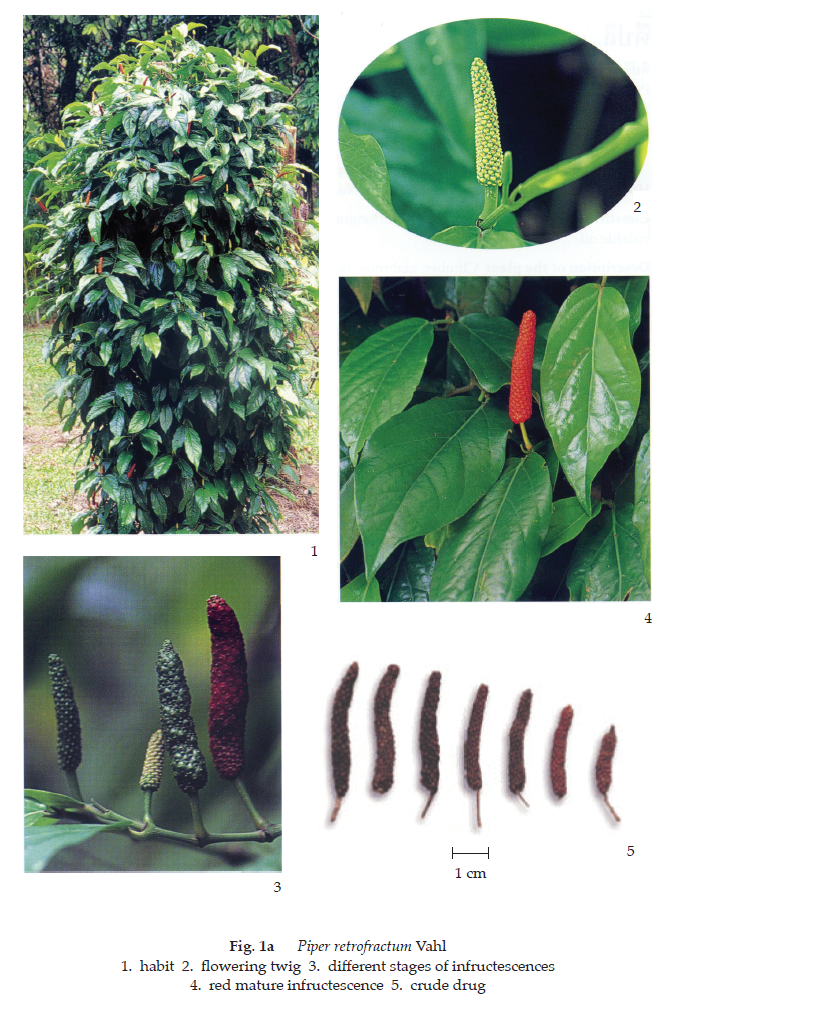
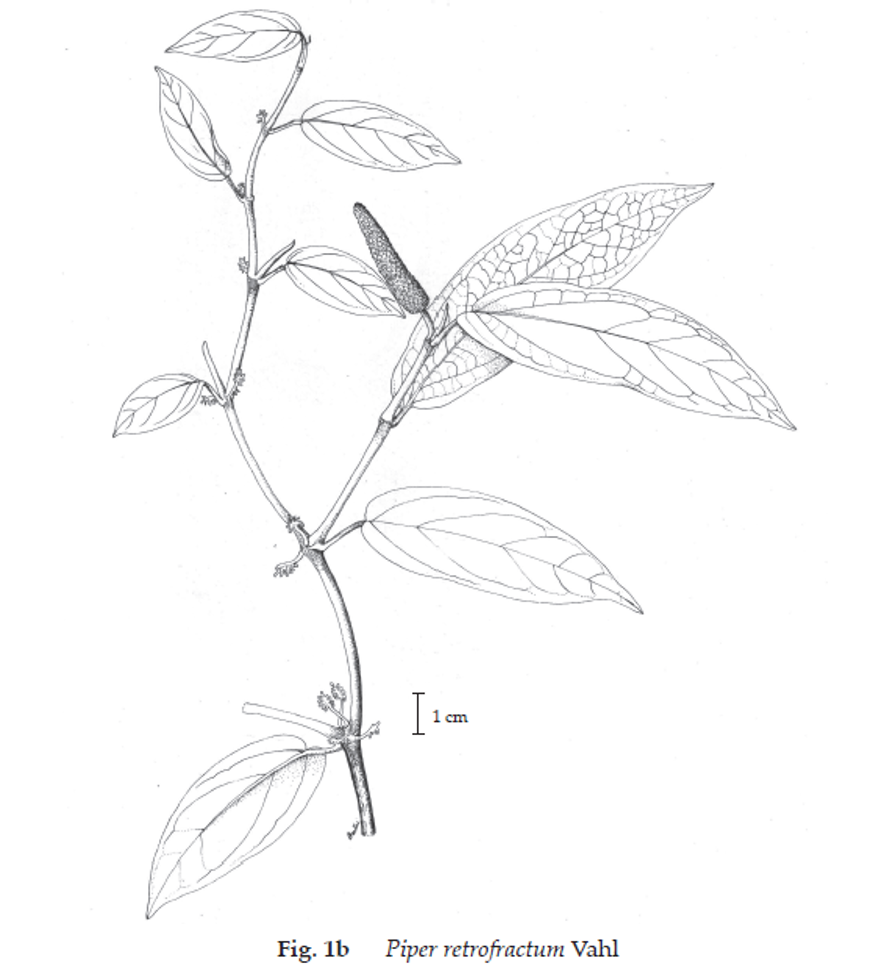
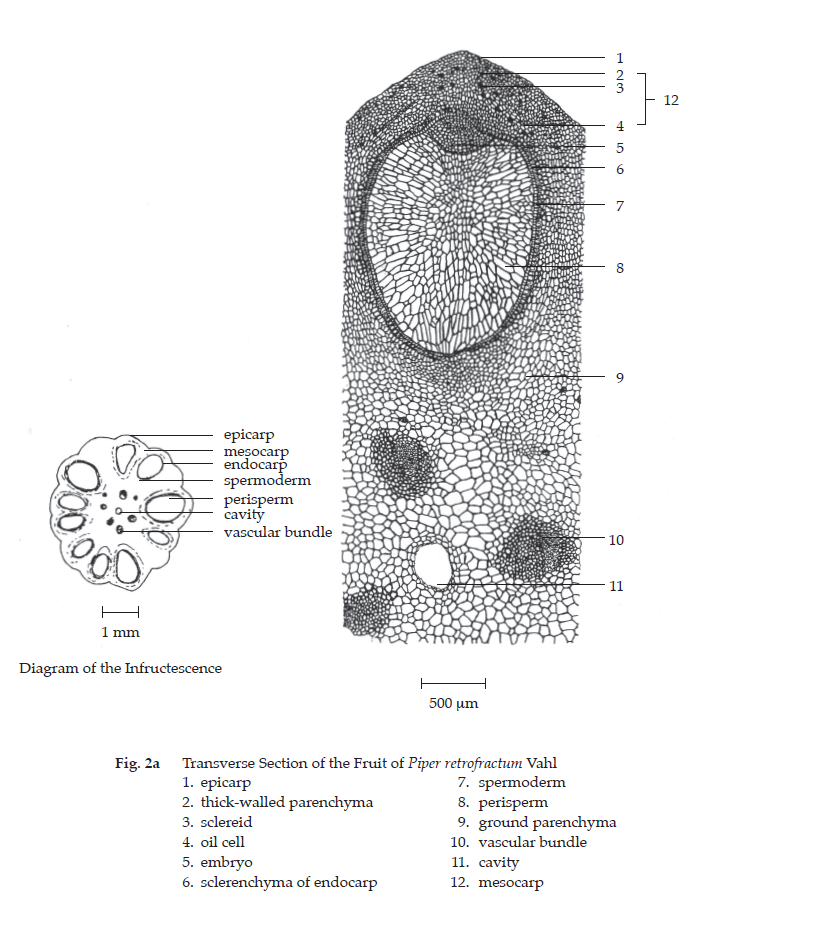
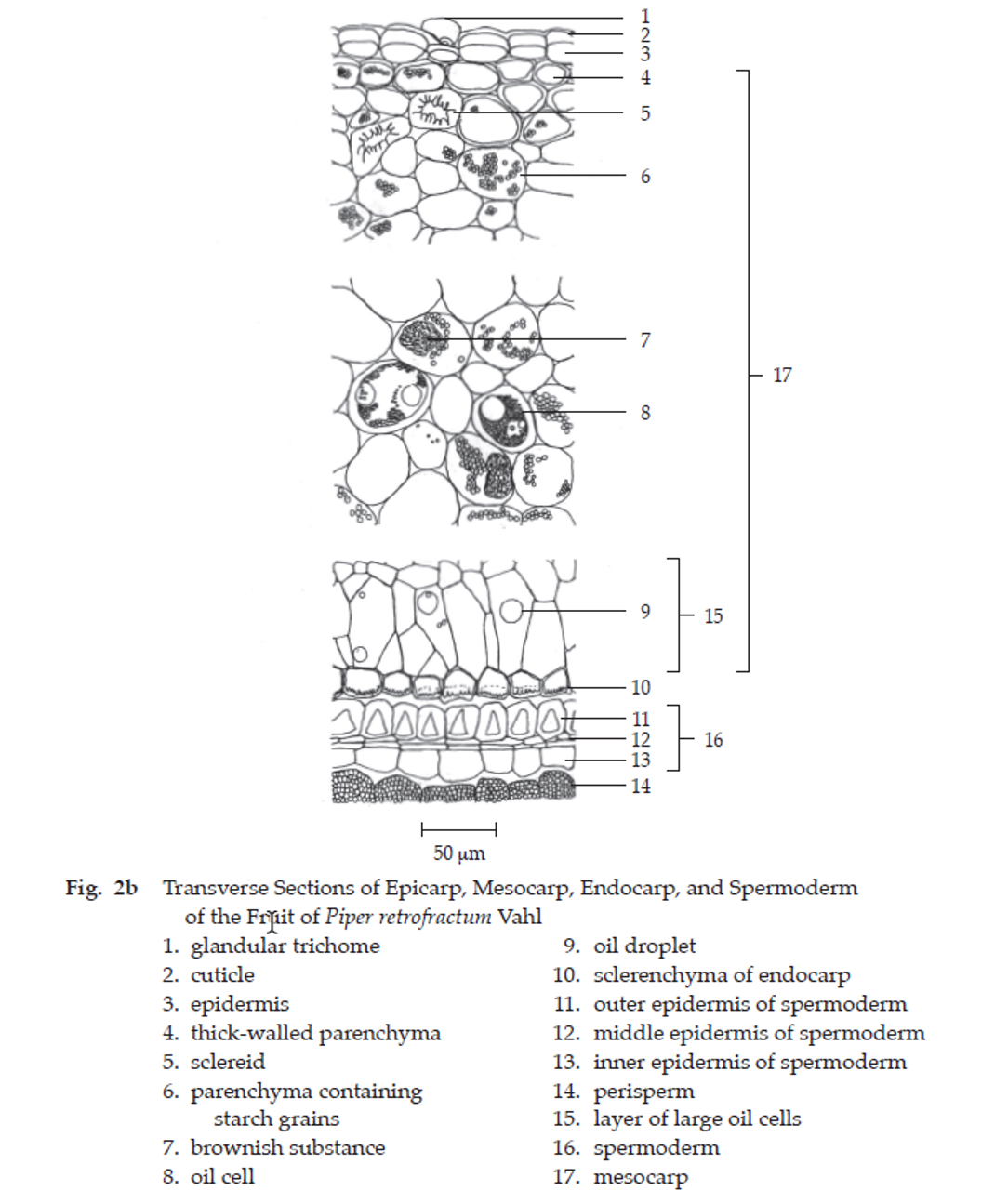
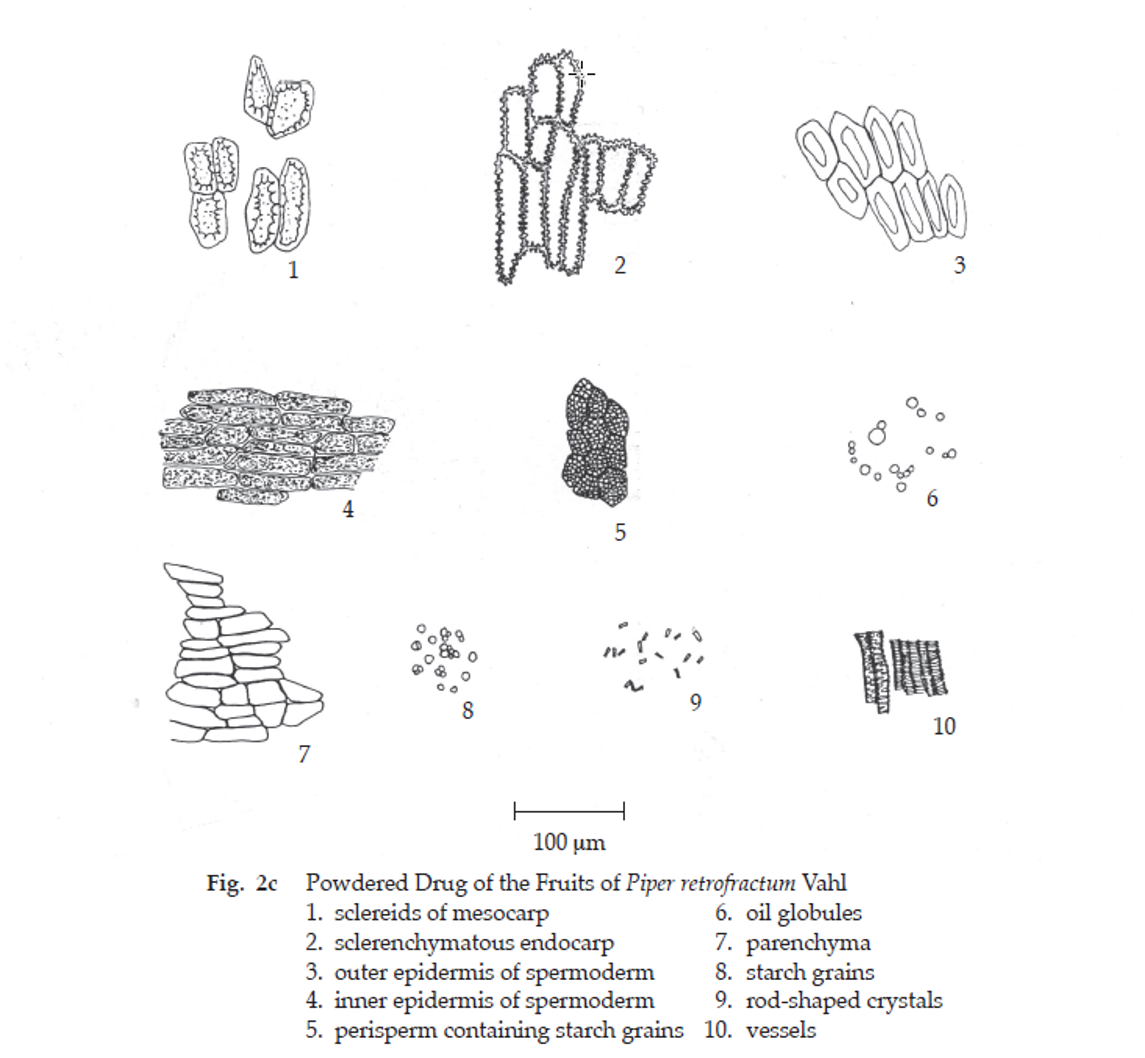
Packaging and storage Java Long Pepper shall be kept in well-closed containers, preferably of metal or glass, protected from light and stored in a cool and dry place.
Identification
A. Reflux 1 g of the sample, in powder, with 25 mL of ethanol for 10 minutes and filter (solution 1). To 2 mL of solution 1, add a few drops of ninhydrin TS and warm in a water-bath for a few minutes: a purple colour is produced.
B. Evaporate 2 mL of solution 1 to dryness. Dissolve the residue in 2 mL of acetic anhydride, and then slowly add 1 mL of sulfuric acid to form two layers: a brown ring develops at the zone of contact.
C. Evaporate 2 mL of solution 1 to almost dryness and add a few drops of Marquis’reagent, prepared by adding a few drops of formaldehyde solution to 6 mL of sulfuric acid: a brownish red colour is produced.
D. To 100 mg of the sample, in powder, add 1 mL of sulfuric acid: a deep red colour is produced at first, turning to reddish brown and brown.
E. Carry out the test as described in the “Thin-Layer Chromatography” (Appendix 3.1), using silica gel GF254 as the coating substance and a mixture of 70 volumes of n-hexane and 30 volumes of ethyl acetate as the mobile phase and allowing the solvent front to ascend 12 cm above the line of application. Apply separately to the plate, 5 µL each of the following two solutions. Prepare solution (A) by macerating 500 mg of the sample, in powder, with 25 mL of chloroform for 15 minutes and filtering. Evaporate the filtrate to dryness and dissolve the residue in 2 mL of chloroform. For solution (B), dissolve 2 mg of piperine in 1 mL of chloroform. After removal of the plate, allow it to dry in air and examine under ultraviolet light (254 nm), marking the quenching spots. The chromatogram obtained from solution (A) shows a quenching spot (hRf value 20 to 22) corresponding to the piperine spot from solution (B), and several spots of higher hRf values. Spray the plate with modified Dragendorff TS2; the spot due to piperine is orange and one orange spot is observed (Table 1); see also Fig. 3.
Repeat the same procedure on another plate but spray with anisaldehyde TS. The chromatogram obtained from solution (A) shows a green spot (hRf value 20 to 22) corresponding to the piperine spot from solution (B), and several other spots of different colours are also observed (Table 1); see also Fig. 3.
Table 1 hRf Values of Components in Chloroform Extract of the Fruits of Piper retrofractum Vahl
| Spot |
hRf Value |
Detection | ||
| UV 254 | Modified Dragendorff TS2 | Anisaldehyde TS | ||
| 1 2* 3 4 5 6 7 8 9 10 11 12 13 |
5-6 20-22 25-77 31-33 36-38 43-44 50-51 58-59 60-61 64-66 66-69 74-77 91-95 |
- quenching quenching quenching quenching quenching quenching - quenching - quenching quenching - |
- orange pale orange - - - - - - - - - - |
pale violet green green violet violet purple - pale violet - violet - blue violet |
*piperine
Water Not more than 13.0 per cent v/w (Azeotropic Distillation Method, Appendix 4.12).
Acid-insoluble ash Not more than 0.4 per cent w/w (Appendix 7.6).
Total ash Not more than 7.5 per cent w/w (Appendix 7.7).
Ethanol-soluble extractive Not less than 10.0 per cent w/w (Appendix 7.12).
Volatile oil Not less than 1.0 per cent v/w (Appendix 7.3H). Use 25 g, in fine powder, freshly prepared and accurately weighed. Use 250 mL of water as the distillation liquid and a 500-mL round-bottomed flask. Distil at a rate of 2 to 3 mL per minute for 5 hours. Use 2.0 mL of xylene in the graduated tube.
Alkaloids content Not less than 2.5 per cent w/w of alkaloids, calculated as piperine, when determined by the following method. (Note Use light-resistant glassware to reduce photodegradation of piperine in solution.)
Standard piperine solution Dissolve about 10 mg of piperine, accurately weighed, in sufficient 1,2-dichloroethane to produce 100.0 mL.
Standard piperine curve Transfer into six 100-mL volumetric flasks, 1, 2, 3, 4, 5, and 6 mL, respectively, of Standard piperine solution, dilute to volume with 1,2-dichloroethane, and mix. Measure the absorbances of the standard solutions relative to the blank at 342 nm (Appendix 2.2). Plot the readings and draw the curve of best fit.
Procedure Place about 500 mg of Java Long Pepper, in fine powder and accurately weighed, in a soxhlet apparatus. Add a sufficient quantity of 1,2-dichloroethane and extract, until complete extraction of the alkaloids is effected (Appendix 7.4). Transfer the dichloroethane extract to a 100-mL volumetric flask and dilute with 1,2-dichloroethane to volume. Transfer 2.0 mL of this solution to a 100-mL volumetric flask and dilute with 1,2-dichloroethane to volume. Measure the absorbance of the resulting solution, at the maximun at about 342 nm (Appendix 2.2). By reference to the standard curve, calculate the content of alkaloids as piperine in the sample.
Dose 200 to 500 mg three times a day.
